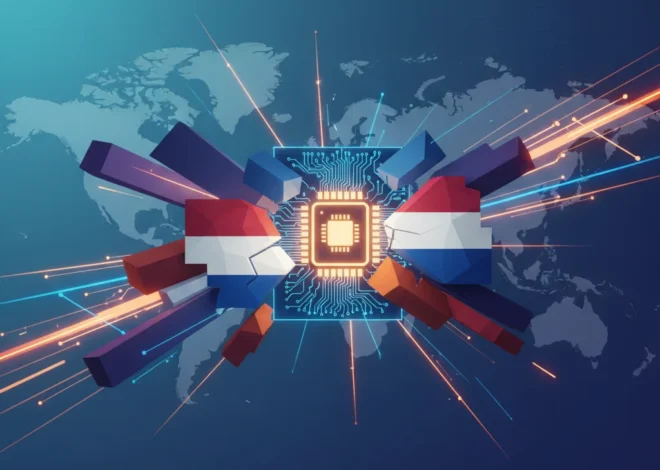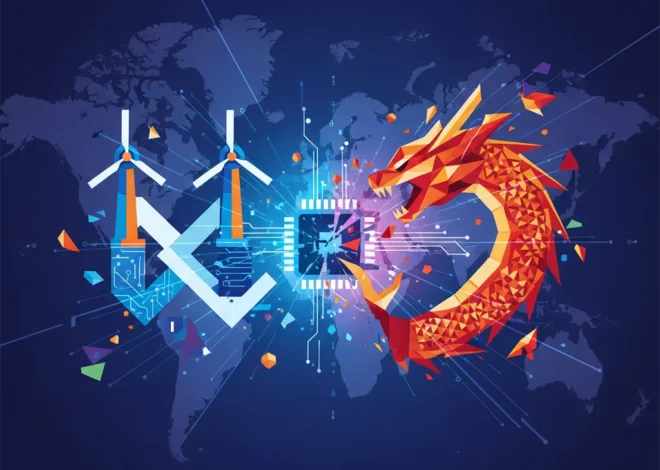
Silicon Desert vs. Dragon’s Memory: The High-Stakes Global Battle for Chip Supremacy
In the quiet expanse of the Arizona desert, a technological mirage is slowly, painstakingly taking shape. Cranes dot the skyline, and billions of dollars are being poured into the sand to build the future of American manufacturing. Meanwhile, halfway across the world, a Chinese tech champion, once thought to be crippled by sanctions, is quietly achieving the impossible. These two stories—America’s ambitious gamble to reshore semiconductor production and China’s defiant leap in memory chip technology—are not separate headlines. They are two fronts in the same global war, a high-stakes conflict that will define the future of everything from artificial intelligence and national security to the very device you’re reading this on.
The global economy runs on semiconductors, the microscopic brains powering our digital world. For decades, the West outsourced the production of these critical components, creating a hyper-efficient but dangerously fragile global supply chain. The pandemic and rising geopolitical tensions shattered that illusion of stability. Now, a new era is dawning, one defined by technological sovereignty and a frantic race to control the means of production. Let’s dive into the two epicenters of this struggle: the dusty plains of Arizona and the state-backed labs of China.
The Arizona Gamble: Can America Rebuild Its Chip Empire?
The vision is grand: transform Phoenix, Arizona, into a “Silicon Desert,” a sprawling hub of advanced semiconductor manufacturing that rivals anything in Asia. At the heart of this dream is Taiwan Semiconductor Manufacturing Co. (TSMC), the world’s most advanced chipmaker, which has committed to a colossal $40 billion investment to build two state-of-the-art fabrication plants, or “fabs.”
This monumental project, heavily subsidized by the U.S. government’s CHIPS and Science Act, is America’s flagship effort to bring critical manufacturing back home. The goal is to reduce reliance on Taiwan—an island nation that produces over 60% of the world’s semiconductors and faces constant geopolitical pressure—and secure the supply chain for the next generation of AI, cloud computing, and military technology.
But building a fab is one thing; creating a thriving ecosystem is another. The Arizona project has been plagued by a series of harsh realities, a clash of expectations versus on-the-ground execution.
As the Financial Times and Nikkei Asia have reported, the project is facing significant headwinds. The initial 2026 production start for the first fab has been pushed to 2025, while the second, more advanced fab’s timeline has been delayed to 2027 or 2028 (source). The reasons are a complex mix of logistical nightmares, a shortage of skilled labor, and significant cultural friction between TSMC’s demanding, high-speed Taiwanese work culture and the expectations of the American workforce.
Let’s break down the promises versus the current reality:
| The Promise of Silicon Desert | The On-the-Ground Reality |
|---|---|
| Rapid Construction & Launch: Initial plans targeted an aggressive timeline to get U.S.-made advanced chips online quickly. | Significant Delays: Both fabs have seen their launch dates pushed back due to construction and equipment installation challenges. |
| Skilled Workforce Ready: The assumption was that a robust American talent pool could be quickly mobilized. | Critical Labor Shortages: A lack of local workers with the specific skills for installing hyper-advanced machinery has been a major bottleneck. |
| Seamless Cultural Integration: The hope was for a smooth fusion of Taiwanese efficiency and American innovation. | Culture Clash: Reports have surfaced of friction over work-life balance, management styles, and operational protocols. |
| Cost-Effective Production: Government subsidies were meant to make U.S. manufacturing competitive. | Soaring Costs: Construction and labor costs have exceeded initial projections, adding financial pressure to the project. |
These challenges highlight a crucial truth: you can’t just copy-paste a manufacturing ecosystem. The intricate web of suppliers, specialized labor, and institutional knowledge that makes Taiwan a chip powerhouse was built over decades. Replicating it requires more than just capital; it demands a fundamental shift in workforce development, industrial policy, and a deep investment in the automation and software systems that run modern fabs.
The Ghost in the Machine: Unmasking the Human Army and AI Robots Building Your AI
China’s Memory Miracle: The Dragon That Won’t Be Tamed
While America grapples with the pains of rebirth, China is demonstrating shocking resilience. The primary case study is Yangtze Memory Technologies Corp (YMTC), a state-backed champion in the field of 3D NAND flash memory—the chips that store data in your smartphone, laptop SSD, and data centers.
In 2022, the U.S. placed YMTC on its “Entity List,” a move designed to cut it off from American technology and equipment, effectively a death sentence for any company trying to compete at the cutting edge. Most analysts predicted YMTC’s progress would grind to a halt. They were wrong.
Against all odds, YMTC has reportedly made a major breakthrough. According to industry analysts, the company is now mass-producing highly advanced 232-layer 3D NAND chips (source). This puts them on par with global leaders like Micron and SK Hynix, a feat that should have been impossible without access to Western equipment.
How did they pull it off? It’s a masterclass in strategic foresight and relentless state-driven will:
- Stockpiling: Anticipating sanctions, YMTC likely stockpiled critical foreign-made equipment for months or even years.
- Domestic Substitution: China has been pouring billions into developing its own semiconductor equipment industry. While not yet at the absolute cutting edge, Chinese suppliers are becoming “good enough” for many process steps.
- Process Innovation: YMTC has likely innovated its programming and manufacturing processes to achieve advanced results with slightly older or domestically-sourced machinery. This is a testament to the power of human ingenuity under pressure.
The implications are profound. First, it proves that U.S. sanctions, while damaging, are not a silver bullet for halting China’s technological progress. Second, with YMTC back in the game and backed by the state, the global memory market could be heading for a brutal price war. This could be great news for consumers and data-heavy SaaS companies in the short term, but it could also decimate the profitability of Western and Korean memory makers.
A Tale of Two Strategies: The Global Chip War Heats Up
What we’re seeing are two fundamentally different approaches to securing technological dominance, each with its own strengths and weaknesses.
| Factor | United States’ Strategy (The “Onshoring” Play) | China’s Strategy (The “Self-Sufficiency” Play) |
|---|---|---|
| Primary Goal | Supply chain resilience and regaining leadership in leading-edge logic chips (processors, GPUs). | Technological independence from the West and dominance in mature/commodity markets (like memory). |
| Key Method | Attracting foreign expertise (TSMC, Samsung) with massive government subsidies (CHIPS Act). | Massive state investment in domestic champions, process innovation, and building a full domestic supply chain. |
| Core Strength | Access to the world’s best technology and intellectual property (for now). | Unwavering political will, huge domestic market, and a high tolerance for short-term financial losses. |
| Major Challenge | High costs, labor shortages, and the difficulty of rebuilding an entire industrial ecosystem. | Remaining cut off from the absolute cutting-edge equipment (like EUV lithography), risking a long-term tech gap. |
For tech professionals, developers, and entrepreneurs, this geopolitical chess match is not an abstract concept. It directly impacts your world. The performance of your machine learning models depends on the availability of advanced GPUs, the core of the U.S. strategy. The cost of storage for your cloud-based SaaS application could plummet thanks to China’s memory push. The stability of your hardware supply chain and the underlying cybersecurity of your components are now central questions in this global rivalry.
Is the AI Gold Rush a House of Cards? Why a Top Bank is Quietly Hedging Its Bets
The Dawn of a New Tech World Order
The stories of Arizona’s awakening and China’s memory boost are the opening chapters of a new, more fractured, and more competitive era in technology. The era of seamless, globalized supply chains is over. In its place is a multipolar world where technological sovereignty is paramount.
The struggle in the Arizona desert shows that reshoring is a marathon, not a sprint. It’s a generational challenge that requires more than money—it requires patience, cultural adaptation, and a renewed respect for the art of manufacturing. Meanwhile, China’s defiant success in memory chips is a stark reminder that you can never count out a determined rival with immense resources and a powerful sense of national purpose.
The battle for semiconductor supremacy is just beginning. The winners will not only control the foundational technology of the 21st century but will also hold the keys to economic prosperity, military superiority, and the future of innovation itself. For all of us in the tech world, it’s time to buckle up. The ground beneath our feet is shifting.


